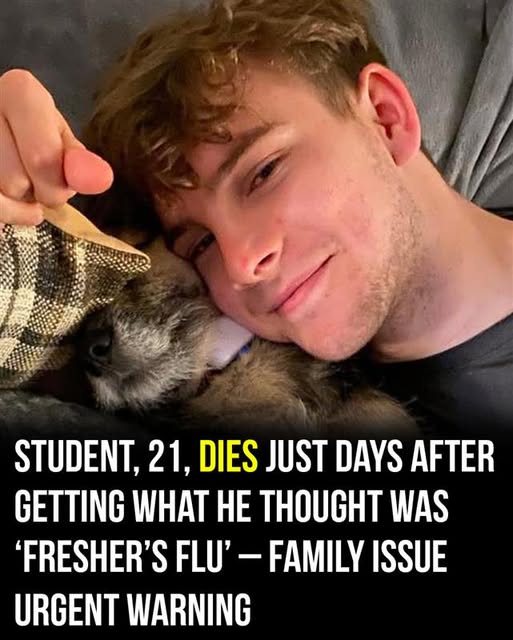Life can change in a heartbeat. For the Martin family, a series of seemingly ordinary symptoms in their 21-year-old son, Lucas, would soon escalate into a tragedy that no parent ever wants to face. What began as what appeared to be a typical post-university illness became a life-altering event that not only changed their world forever but also motivated them to create a legacy to protect others.
A New Chapter, an Unexpected Illness
Lucas Martin had just completed his studies at the University of Liverpool, brimming with optimism about the next chapter in his life. Between job applications, travel plans, and social events with friends, he carried the excitement and nervous energy common to young adults stepping into the world.
But when he returned home one evening complaining of fatigue, a persistent headache, and general malaise, his family didn’t suspect anything serious. “It was probably just fresher’s flu,” his mother thought. Many students, especially during transitional periods like university graduation or returning home after exams, experience bouts of exhaustion and mild illness. Lucas himself shrugged off his symptoms, insisting that rest would suffice. His parents, like countless families in similar situations, accepted his explanation at face value.Yet, beneath the surface, something more serious was beginning to develop.
Early Signs That Were Easily Missed
In the first days of his illness, Lucas displayed symptoms that seemed mild but unusual. He felt unusually drained despite sleeping for long stretches. He occasionally lost his train of thought mid-sentence, and a slight fever caused him to seem drowsy and disconnected. His younger brother, Connor, later reflected on how normal it all appeared at the time: “It looked like a simple virus. We never imagined it could be anything more dangerous.”
There were no classic warning signs often associated with severe infections: no visible rash, no neck stiffness, no sudden sensitivity to light. These missing red flags would ultimately make the situation more deceptive, illustrating just how easily serious illnesses can masquerade as minor ailments.On the evening of September 9, Lucas opted to rest on the sofa with a blanket, unusually quiet. When asked if he needed anything, he shook his head and murmured, “I’ll be fine tomorrow.” It was an ordinary scene in an ordinary household—but the ordinary was about to shatter.
The Sudden Escalation
The following morning, September 10, the Martins awoke to a terrifying sight. Lucas was sitting on the edge of his bed, struggling to speak. His words were slurred, his eyes wide with panic, and he continuously rubbed his temples as though trying to ease an invisible pressure. His parents immediately recognized that something was seriously wrong.They rushed him to the hospital, where medical staff quickly assessed his condition. His confusion intensified, his fever spiked, and the words that every parent dreads were spoken: meningitis.
Meningitis is a severe bacterial infection that can progress rapidly. It attacks the protective membranes surrounding the brain and spinal cord and, without prompt treatment, can be fatal. The speed and unpredictability of its progression often leave families stunned and helpless.
A Fight Against Time
Lucas was moved to the intensive care unit and placed in an induced coma to protect his brain from swelling. His parents and brother watched in disbelief as machines took over functions his body once performed naturally. Each beep, each blink of the monitor, reinforced the surreal reality that their once-healthy son was now fighting for his life.For two days, the family lived in the ICU waiting room, caught between hope and dread. Hours blurred into each other under the cold fluorescent lights. Nurses came with updates, each one bringing a mixture of medical facts and emotional weight. Connor replayed memories of Lucas: the laughter-filled evenings, the ambitious plans for the future, and the effortless way his presence could uplift a room.
Despite the overwhelming fear, hope persisted. “We kept telling ourselves he’d pull through,” Connor recalled. “He was strong, he was young, and he had so much ahead of him.”
A Tragic Loss
But the infection progressed too quickly. On September 12, just 48 hours after being admitted, Lucas’s body succumbed to the illness. At 2:14 p.m., doctors informed the family that nothing more could be done. In that instant, their world fractured.
Connor remembers the scene vividly—the sterile smell of disinfectant, the silence of monitors, his mother’s anguished cries. Lucas appeared peaceful, as if merely sleeping, but the reality was that his life had ended far too soon.
Lucas had been the heart of his family, full of energy, ideas, and uncontainable spirit. Losing him felt like losing the very ground beneath their feet. In a matter of days, the family confronted a reality they never could have anticipated: that a young life, full of promise, could end suddenly and unexpectedly.
Understanding the Illness
In the aftermath, the Martins sought to understand what had happened. They learned that some forms of meningitis can present subtly, without the hallmark rash or other commonly recognized warning signs. In such cases, the infection advances with alarming speed, often leaving families unaware until it is too late. The devastating truth is that early recognition is the only chance for survival.
Connor later shared the family’s experience publicly, urging others not to dismiss concerning symptoms. “If you’re worried, seek help immediately. Don’t assume it’s just the flu,” he advised, his voice breaking. “We waited, thinking we were being reasonable. We will regret that for the rest of our lives.”Creating a Legacy from Tragedy
Determined to prevent other families from experiencing similar heartbreak, the Martins founded Looky’s Aid, a charity named after Lucas’s childhood nickname. The organization focuses on educating young people and parents about the warning signs of serious illnesses, providing scholarships, and offering health awareness programs.
The mission is clear: ensure that students and families recognize danger early, that timely medical intervention is sought, and that preventable tragedies are reduced.
Impact and Awareness
Since its founding, Looky’s Aid has reached thousands through schools, universities, clinics, and online platforms. Messages poured in from students who sought urgent care after learning about Lucas’s story. Parents reported that they were now equipped to recognize symptoms that might otherwise have gone unnoticed. Some even credited the awareness programs with saving lives.
Lucas’s story, while tragic, became a beacon of hope. It demonstrated that even a life cut short could inspire awareness, education, and preventive action for countless others.
The Continuing Influence
Today, Lucas Martin’s story is shared across multiple platforms. Universities incorporate his story into health orientations. Parent groups discuss it to highlight the importance of vigilance. Clinics and healthcare providers use it as a teaching tool for both medical staff and families.His influence reaches far beyond his immediate circle, touching lives in ways he never could have imagined. Through awareness campaigns and health education, Lucas continues to impact the world—a testament to the enduring power of a young life devoted to dreams and relationships, even if only briefly lived.
Lessons Learned
The Martins’ experience underscores critical lessons for all families. First, never underestimate subtle symptoms. Fatigue, mild fever, confusion, and headaches—even without classic signs—can indicate serious health concerns. Second, timely medical attention is paramount. Rapid intervention can mean the difference between life and death. Third, turning grief into action can create positive change.Lucas’s story exemplifies resilience and hope. While his life ended prematurely, the knowledge shared through his legacy continues to protect young people everywhere. Families who engage with Looky’s Aid and similar programs are more prepared, more vigilant, and ultimately more empowered to respond in emergencies.
Conclusion
The story of Lucas Martin is a reminder that life is fragile, often unpredictable, and profoundly precious. It teaches parents, students, and communities the value of awareness, the urgency of early intervention, and the transformative power of turning personal loss into meaningful action.
While the Martins will always grieve the loss of their vibrant son, they have ensured that his story creates ripples of education and hope. Lucas’s life, brief yet impactful, continues to save lives, protect families, and inspire action.
In the end, his legacy is not just a memory—it is a lifeline, a cautionary tale, and a source of hope for countless families who might otherwise face tragedy alone. Through awareness, vigilance, and compassion, the Martins honor Lucas, proving that even in the face of devastating loss, love and action can endure.



